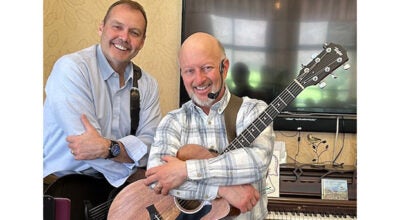College host CSI camp for children
Published 6:00 pm Wednesday, July 2, 2014

Colorful Blue Crew groupies try to sway prosecutors’ investigation with incriminating photos. (Submitted photo)
Combine Smurfs and Blue Man Group and you get “azure” thing — Educational Talent Search at Southwestern Michigan College’s ninth annual CSI Academy for 30 Cass County middle schoolers.
A week-long foray into forensics slips science and mathematics into summer fun for sixth, seventh and eighth graders from Dowagiac, Cassopolis, Edwardsburg, Marcellus and Brandywine.
So successful has the federally-funded ETS program been that it produced Director Amy Anderson and 2014 valedictorians Austin Broda of Dowagiac and James Chapman of Edwardsburg.
Each, along with Dowagiac Top 10 graduate Mackenzie Ruff, landed $45,000 University of Michigan scholarships.
Characters include drummer Paul “Papa” Smurf (Phil Small of the Cass County Sheriff’s Office); his two brothers, Ringo “Grouchy” Smurf, found by the librarian strangled and stabbed three times in Mathews Conference Center West; skeletal remains of John “Brainy” Smurf, missing for five years; Betty Jean the Gambling Queen (Terri McCraner from the Prosecutor’s Office); the Blue Man Crew (launched with a $9 million inheritance; grudges galore suggest motive); and cyan fans, portrayed by Anderson (Azura Peacocka) and MaKenzie Kreiner of the Sheriff’s Office (B’lue Berry).
Thursday’s visit to the Michigan State Police in Niles and Trooper Rob Herbstreith and to the South Bend Crime Lab, leads up to Friday’s mock trial coached by real attorneys at the Cassopolis Law and Courts Building before COA jurors.
In a makeshift medical examiner’s office (staffed by Anderson’s lab-coated alter ego, Dr. Rig R. Mortis), students learn algor, rigor and livor mortis and the distinction between types of bruises, such as hematomas (blood pools outside of vessels) and contusions (smaller, outside capillaries).
Algor mortis is body temperature reduction in a corpse, dropping one degree Celsius an hour. A reading of 32 indicates five hours elapsed from the normal 37.
Livor mortis refers to body color. Bright red indicates poisoning, such as carbon monoxide or cyanide. Brown, some other type of poison requiring toxicology to pinpoint. Greyish-green, “like a zombie,” means the body is already decomposing; purple or black if advanced.
Lacerations, the technical term for cuts, can hurt worse if superficial, depending on nerves exposed. Abrasions are less severe, like a knee skinned falling off a bike.
Avulsions mean skin torn away, creating a flap.
“Police work is 90 percent boredom from the same stuff over and over again,” Dowagiac Police Department veteran CSI technician James Kusa said while discussing blood spatter spines and satellites, “and 2 percent sheer panic.”
“You know something’s going to happen where your heartbeat goes from zero to 60,” like the time a nude intruder put a shotgun under his chin and blew his face off as Kusa and his partner closed in.
The surprising suicide suspect survived to live for years with his facial features reconstructed.
Parole agent Amanda Osborn brought in tools of her trade.
“Kids thought it was great doing a breathalyzer with Listerine,” Anderson said. “They got tethered. On Friday morning the warrant service team demonstrates how it responds to someone who holes up in a building,” including Tasers.
These tidbits turn into tools for witness interviews.
Assistant Prosecutor Tiffiny Vohwinkle helps determine whether premeditation exists to warrant two first-degree murder counts and who should be compelled to testify so cadets can prove their case beyond a reasonable doubt.
All strands of evidence-handling, fingerprint dusting, soil, blood and trace analysis, crime scene sketching and impressions converge in court to confirm the culprit and to bring them to Justice (Wirick-Garrelts).
The Dowagiac seventh grader aspires to be an attorney.
“Two thirds of our kids are low-income or first generation to go to college. A third can be anybody, so we have the top 10, the lower 10 and everybody in between,” Anderson said. “Our program goes sixth through 12th grade, then we follow them six years after high school. We have 700 students a year and have graduated almost 4,000. During the school year, we locate in school guidance offices.”
Fire Academy wrapped recently. There was social studies-related Exploration. Next comes Art and Design on Grimm’s
fairy tales.
“Every other week we have a camp until school starts,” Anderson said, including Mystery, around career, college and military; Geotrek college visits (last year, Berea College in Kentucky and the University of North Carolina at Asheville, with cave spelunking); Weird Science (amusement park physics, Great America); and Spy School (early rising at Camp Eberhart to get back in the habit the week before classes start).
“Our program helps kids apply to college,” Anderson said. “Because we’re federally-funded, they can apply to any school they want and not pay the application fee. They also get fee waivers to take the ACT or SAT over again. We get them ready for those tests. We require all seniors to apply to three colleges — even if they know they’re going into the military — two scholarships, do financial aid paperwork and learn etiquette.
They’re relieved of cell phones, which a security officer banishes to a box labeled “jail.”
DPD Chief Tom Atkinson, now SMC chief of staff, originated the CSI concept a few years before ETS adopted the academy.






